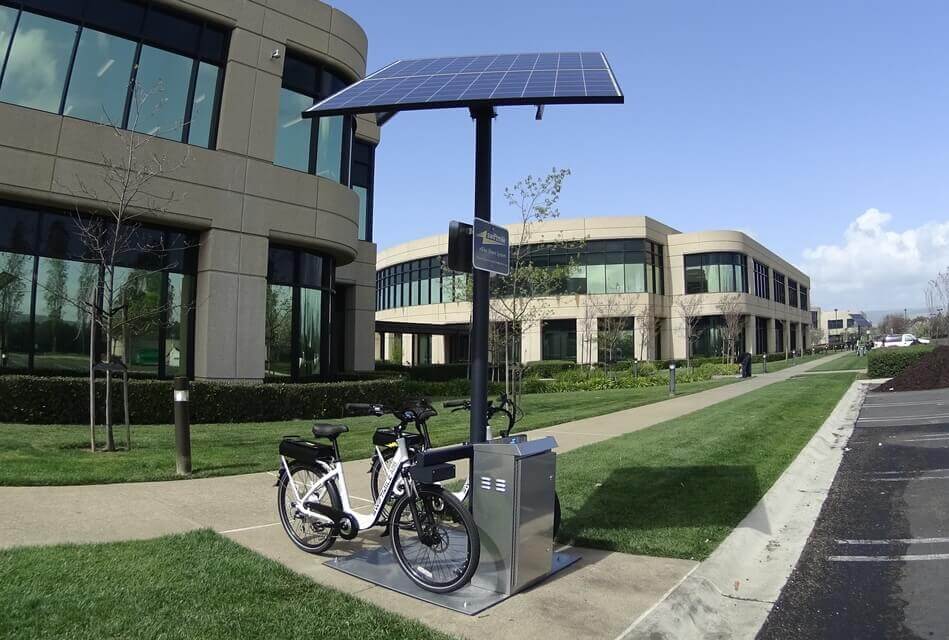The second of our two-part feature continues with Leo Vera, Chief Operations Officer and co-founder of Swiftmile, about how his company and Reinvently worked together. Swiftmile’s other co-founding veteran team include Colin Roche (CEO), Keith Moravick (CTO) and John McGraw (CBDO). Headquartered alongside us in Palo Alto, California, Swiftmile makes and deploys electric charging stations for eScooters and eBikes in the MicroMobility market. Here, we continue starting with the transition from the eBikes model to focus on their Electric Charging Station platform. If you haven’t seen it, the first part of our interview with Leo talks about our work with the Mobile App for Swiftmile’s eBikes.

A Swiftmile Station at Tesla.
Mark: Let’s expand a bit more on how Swiftmile used its Minimum Viable Product to get to where it is now and where it’s going.
Leo: Well, we anticipated that the bikesharing market would move from pedal bikes to electric-powered bikes. Colin’s research indicated that a lot of pedal bikes, and other MicroMobility vehicles, would eventually go electric and were in the process of doing so. To us, it wasn’t a question of if, just when it would achieve a critical mass. At the time of launching our MVP, there were no shared bikes devoted to commuters and corporate enterprise. So, we were essentially forced to create our own system, but it was really just a step to the bigger picture.
Our solar-powered electric charging stations are and were the central component. The real, true focus of our system. By developing and aiming to be first-to-market with an extensible system, we’d be in a position to provide charge management and infrastructure capabilities. That would enable us to partner with eBike operators, instead of competing with them, to lead the value here and monetize it over time.
We just didn’t expect it to happen so quickly. The speed of the scooter-revolution and emergence of all these MicroMobility companies took us a little bit by surprise. Even so, we were relatively well prepared for it. It’s created a ton of value for us – we’ve been pretty lucky.
Our original IP filing identified all of the different vehicle types that we knew “someday” would be electrified. Every year, we’ve seen something innovative and different hit the market – scooters, bikes, three-wheelers. So, in going universal, a big part of the equation was reaching a point where the type of vehicle didn’t really matter.
Mark: That’s worth exploring further, because it sounds like you have two distinct, but overlapping business models in play. Maybe you can elaborate on how your systems work for your respective target markets?
Leo: So, there’s the app, and then there’s the back end. So, it’s like two separate (but closely integrated) products. The current Swiftmile app is really for the eBike rental system and the end-user/commuter who are employees of one of our corporate clients. It has a very flexible payment system, which a lot of other companies in this market don’t have. We’ve identified the types of riders in conjunction with their commute or casual time-windows. So, depending on usage, it can be partially subsidized by the corporation, depending on how the bike is used to commute.
For one example, Tesla’s paying for commuter rides, but the individual employees pay for rides to have lunch in the city. There’s a lot of data tracking and reporting for both tiers of customers.
In this case, we’re providing everything – a turnkey solution with the bikes, mobile app, charging system, and backend.
Our main focus though is providing the charging system to operators. They manage the rental system on their operations side. They have their vehicles and their own mobile app but use our charging system which consists of the station itself, and our backend. In support of this, Reinvently built the API that operators can integrate with their fleet, enabling proactive communication between their vehicles and our backend. This was our focus in 2018 and it’s really this component that solidifies our initial vision for market position.
We always thought of our system as being able to partner with PET operators so that we could scale beyond ourselves and allow their distribution to actually grow our business. And now, we have several partners that are lined up to implement our new stations. In this case, from a software standpoint, our API is really our product and not the mobile app.
Mark: And again, the API came from Reinvently?
Leo: Exactly. They are seamless. Our mobile app uses the same functions, so in a sense, we were our own customer if you will. Our mobile app makes the idea of eBikes on demand work for commuters. In turn, the API enables a third-party’s app or another operator’s app to work with our backend system.
Mark: How unique is the Swiftmile charging platform? That’s serious stuff – it’s not a one-off. And it sounds like no one else or perhaps very few in the MicroMobility market are really thinking from a platform perspective, is that the case?
Leo: Yeah. It’s universal – and that’s the key. We’ve built a solar-powered electric charging station system and everything that goes with it that, to the best of our knowledge, no one else has built. Most MicroMobility operators are scooter or bike operators, really concerned with their own brand and business model. They have an app and vehicles but are still getting to know their customers, and how best to service them. In our platform, we’re really trying to create an infrastructure solution that’s universal to all of the brands, allowing everything to work within our system.
So, we’ve had to think about how we identify a vehicle, manage multiple voltages, different form factors and so many other items while other companies are developing something for themselves, for their own vehicles and customers.
We’ve really created something that we can license around the world and that we’re now presenting to municipalities and metro agencies. It’s a system that a university campus or metro agency can install, and now it can serve any or all of the operators that are out there. We consider it unique, suffice that this approach has required developing a lot of new solutions to make this work, and we’re quite nearly there.
Mark: It’s one thing to have a great app, solid backend, and your own hardware, and something else to go universal with a system that works for all operators. That’s much more ambitious and a lot more complicated. Becoming a true platform player is a very powerful place to be in. How is Reinvently helping to make that possible?
Leo: We had to create a lot of custom business logic, rules, and parameters, including things like covering tax issues. That’s very difficult to do and it takes a lot of time, knowledge and resources. Reinvently’s proven very capable in this for coming to understand our industry and its trends enough to talk us through our requirements and translate it all into a real product idea.
Mark: I’d guess that as you make a change to any of the hardware, you would need to change the firmware and software too – what’s the turnaround time like for that?
Leo: Now, any changes are mostly hardware and firmware related. If we get a new vehicle or lock then we handle that mostly on the hardware side. Everything that we’ve built for the backend is pretty extensible. It just needs to know the voltage and battery capacity so we can calibrate in a lot of the readings that we get from the backend. That’s pretty much it. At present, we’re able to integrate new vehicles within 30 days; some might take longer, but again, that’s just for the hardware. The software side is able to handle pretty much any type of vehicle, now.
Mark: So, that’s because you have very flexible rules in place that allow this, almost like “if this, then that” – parameters that can be easily adjusted, is that correct?
Leo: Yeah, that’s exactly right. On the software side, it’s not hard-coded like when we built the MVP. There we took some shortcuts, it was really more like a proof of concept enabling us to get in front of investors and clients faster. Since then, we’ve been working to make it universal so it can accommodate just about anything. The core of our electronics was made to accommodate a lot of different power requirements. With new vehicles, we really just need to adapt to their form factor and physical attributes.
Mark: I’d like to follow up for a better understanding of that process because it’s so critical to get the rules right. As you said, going universal provides a bit future-proofing in the sense that you can plug anything and it’ll work. I want to understand the role of Reinvently in defining those rules. You mentioned Reinvently had a definitive role in coming in with the best practices in understanding through your research the market opportunity and what was needed to make it happen. What was Reinvently’s role here?
Leo: Reinvently created the architecture and database structure for us. There are some elements that we created to work with the logic and code to access tables or parameters, however software coding is not our strength. Keith, our CTO, is very good at hardware and software interfaces, so he’s focused on leading the development of our hardware and firmware.
Some companies bring software experts in with their founding team. But, more and more, I think companies should look to partner with companies like Reinvently that have the best practices and expertise behind them, instead of just relying on internal folks to define special requirements.
It was critical for the architecture to be structured in such a way to make it very easy to add new vehicles into the system without having to recode the system. So, accomplishing that and getting us set up on Amazon Web Services (AWS) makes us super-scalable. I’m not worried about suddenly getting orders for thousands of units – we’re quite capable of growing really fast with the system we have now.
Mark: One question out of curiosity, as Artem has mentioned some examples, is whether you’re considering data for monetization purposes, like if riders take a certain route and drive by a restaurant whether that might lead to restaurant advertisements, or something similar?
Leo: Absolutely, it’s not a secret that the shared mobility, on demand and MicroMobility industry, has a huge value not just for the rides people are taking but for the value of information, as well. There are a lot of uses for data – the one you mentioned has a potential commercial value for business advertisers. Another is mapping trends and usage – like with the carbon offset.
There are a lot of sustainability efforts that require companies to have goals for reducing greenhouse gas emissions. We are already providing reports to our customers like Tesla where we can show them exactly much energy we’re putting into solar-powered electric vehicles and what the equivalent carbon offset if they were to drive a regular vehicle. We capture a lot of that data in the backend and there is definitely value in monetizing that non-personal data.
Mark: So, our last question is what’s been the hardest part of launching Swiftmile so far?
Leo: Market creation – creating demand in an industry category that didn’t exist before. There are a lot of things that are always hard like raising capital. Even that is not as difficult as creating a new market, for all practical intents and purposes. That requires a lot of work, a lot of advocacy, an enormous amount of time, going to conferences and trade shows, speaking engagements, press releases and more.
Mark: No doubt market creation is a whole book unto itself, but the way you’ve approached it certainly serves as a primer for new and innovative start-ups. Thank you, Leo, for sharing so much about the Swiftmile journey and how Reinvently’s been an instrumental part of it!
For more about Swiftmile’s MicroMobility Solutions, make sure to check out their website. You’ll see Leo and his team has been very, very busy making the news:
- Scooters are Littering Sidewalks and Injuring Pedestrians. Can This Startup Bring Order to the Chaos? – Washington Post
- Startup Aims to Bring Safety to the Scooter Industry – US News and World Report
- Swiftmile is Pitching Cities Its Solution for Cleaning Up the Scooter-Filled Streets – The Hustle
- The Hot New Thing in Dockless Electric Scooters: Docks – CityLab
- Swiftmile: Solar Powered Electric Bike Rental Stations – Electric Bike Report
- Swiftmile Pics on Pinterest






Leave a Reply